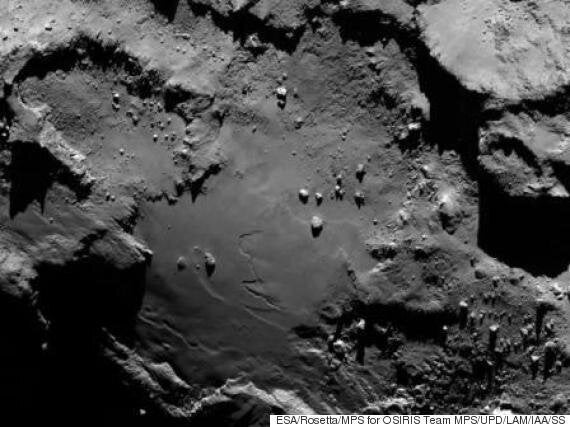If you're wondering what alien life could look like, this is the sort of image you should bear in mind.

While it may look vaguely uninteresting to the naked eye, this is comet 67P/Churyumov–Gerasimenko, where the Rosetta mission landed its Philae probe.
Today, scientists are arguing that its "distinct and unexpected features," are actually signs of extraterrestrial life.
The "features" they speak of is 'a black crust and the underlying ice and images show large, smooth ‘seas’, flat-bottomed craters and a surface peppered with mega-boulders.'
At this year's National Astronomy Meeting, two scientists will tell the world why they believe the comet could be hosting 'alien life.'
Both astronomers argue that the presence of craters "...overlain with organic debris" is a sure sign that small organisms living in the cracks of the comet's ice and snow are colonising the area.
Dr Max Wallis from University of Cardiff and Professor Chandra Wickramasinghe -- the director of the Buckingham Centre for Astrobiology-- explain that the presence of large craters, which are refrozen bodies of water would be perfect for tiny cellular life forms that contain anti-freeze salts, to live on.
As the comet's orbit allows it to experience the sun's warmth, the astronomers say these observed "features are all consistent with a mixture of ice and organic material that consolidate under the sun’s warming...when active micro-organisms can be supported."
The little 'aliens' should become active at around -40 degrees Celsius, a temperature that the comet experienced the last time it was 500 million kilometres away from the sun.
As it travels closer to the sun, the rising temperature should result in the micro-organisms becoming more dynamic and a rise in gaseous emissions.
Both scientists even go as far as suggesting that the comet's freezing conditions would probably be more hospitable than the earth's polar regions.
Dr Wallis said: “Rosetta has already shown that the comet is not to be seen as a deep-frozen inactive body, but supports geological processes and could be more hospitable to micro-life than our Arctic and Antarctic regions”.
According to the Royal Astronomical Society, other data from Philae showing an abundance of organic molecules on the comet is also confirmation of 'alien life'.
READ MORE:
This is not the first time, astronomers have noticed the comet for its unique characteristics. Last year, they detected that water vapour from the comet was drastically different to the composition of water found on earth.
While the claims of extra terrestrial organisms may shed more light on what role comets have played in the origins of life on earth, Professor Wickramasinghe commented that if the findings are true it would mark a significant chapter in astrobiology.
He said: “If the Rosetta orbiter has found evidence of life on the comet, it would be a fitting tribute to mark the centenary of the birth of Sir Fred Hoyle, one of the undisputable pioneers of astrobiology.”